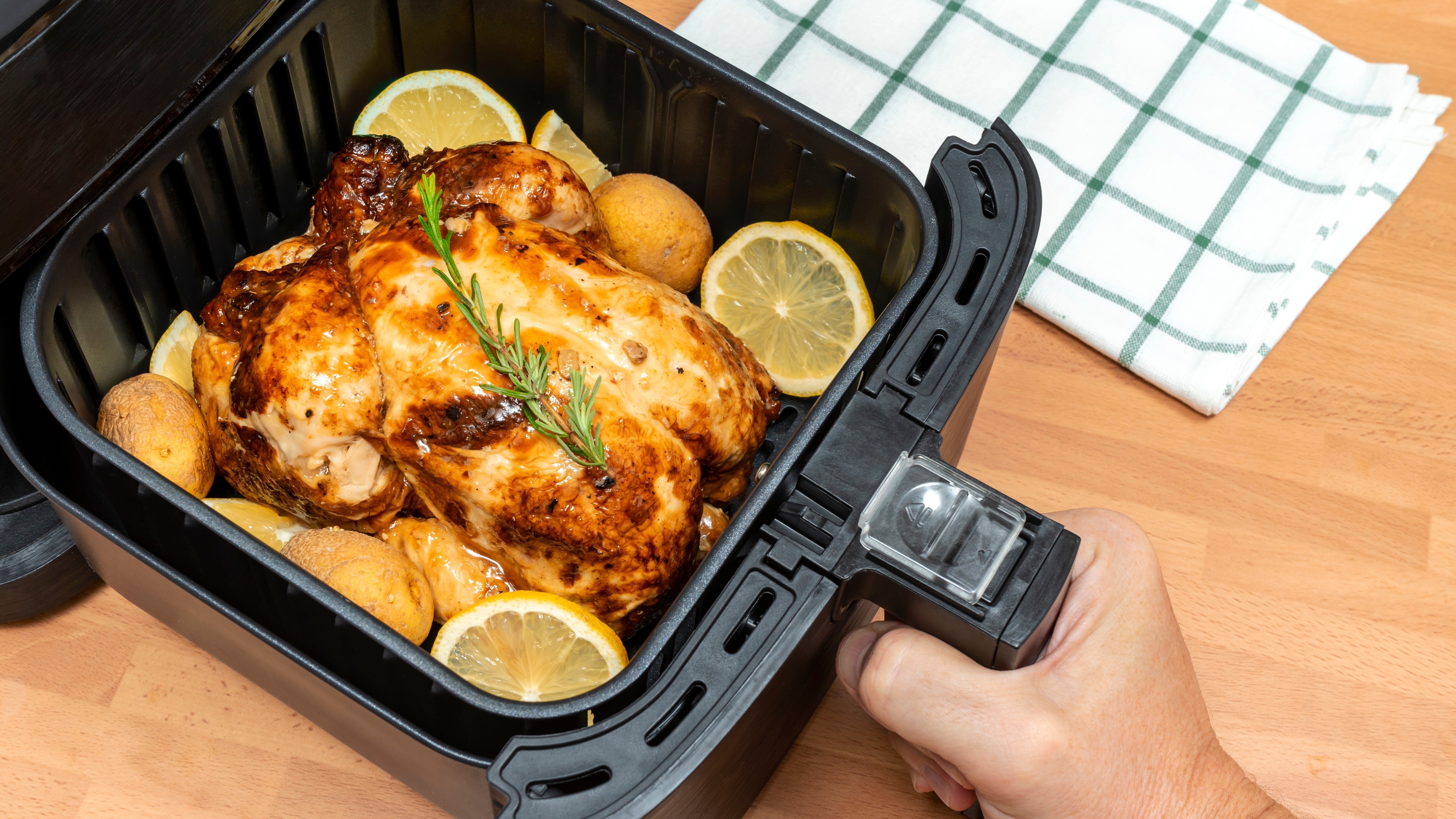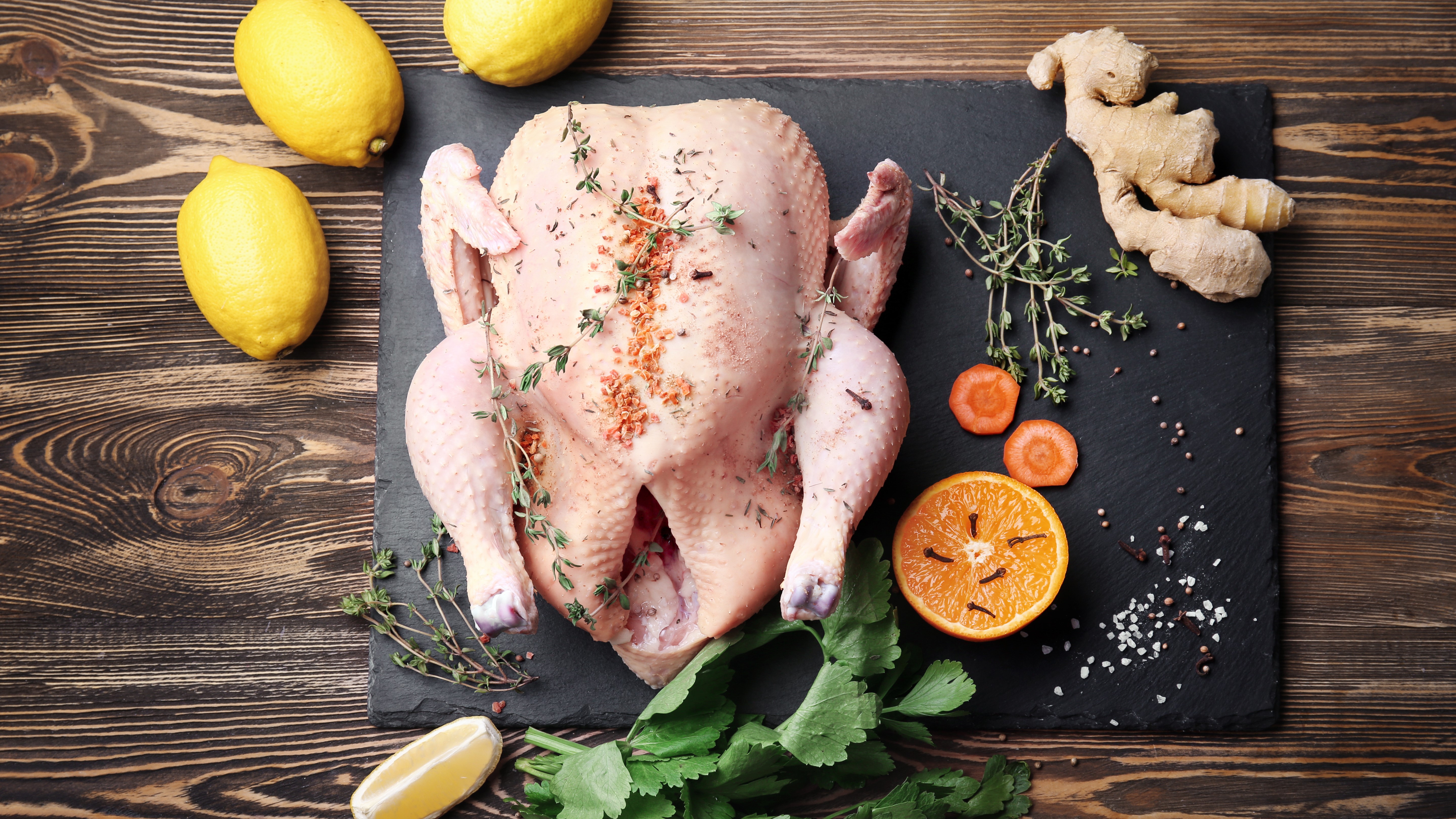Can you cook a turkey in an air fryer?
Air fryers can handle almost anything, but does that include turkey?

Cooking a turkey in an air fryer might sound a bit ambitious, but if you're looking for a quicker and low-hassle way to serve the festive bird this holiday season, it's worth giving it a try.
Unlike traditional roasting methods, air frying a turkey typically requires less hands-on time and attention, which can reduce the stress of holiday cooking. The best air fryers will also circulate hot air around the bird more evenly and precisely than large ovens, making sure it's soft in the center with a cripsy, flavorsome skin.
Below, I explain what you need to consider before, during and after cooking turkey in an air fryer with some tips and tricks that I've learned along the way.
How to cook a turkey in an air fryer
The first, and most important consideration when looking to cook a turkey in an air fryer is the size of the bird. Standard air fryers are typically suitable for smaller turkeys or turkey breasts but may not lend themselves well to the kinds of large birds needed to feed your whole family.

You need to make sure the turkey can fit in the air fryer basket with enough space around it for the hot air to circulate evenly. If the bird is too cramped, or touching the sides, you won't get an even roast and you could even increase your risk of food poisoning from the meat not being cooked properly.
As a guide, and in my experience, a bird that weighs around 9-10 pounds or less can fit in most family-size air fryers. Air fryer instruction manuals will often list the recommended sizes and capacities for different foods if you're unsure. Alternatively, you can either take a tape measure, or the air fryer basket itself with you while shopping.
You may get some funny looks, but it's the safest and most effective way to guarantee you get the optimal size.
Sign up for breaking news, reviews, opinion, top tech deals, and more.
Step-by-step guide
Step 1: Begin by thoroughly thawing the turkey and removing any giblets.
Step 2: Preheat the air fryer to approximately 350°F. The cooking time is generally around 10 minutes per pound, but this can vary based on the air fryer and turkey size.
Step 3: Pat the turkey dry to remove excess moisture. This will prevent too much steam from being released into the air fryer, which can stop the skin from crisping up.

Step 4: Season the turkey both inside and out with your choice of herbs and spices.
Step 5: Place the bird in the air fryer basket and cook until the skin is golden and the juices run clear.
Tip: I recommend using a meat thermometer to make sure the insides are cooked properly and have reached at least 165°F. Ideally, the thigh should be 180°F and the breast should measure 170°F.
How to get the best from your air fryer turkey
Before cooking
For an evenly cooked turkey, bring it to room temperature before air frying. This helps prevent the outside from cooking too quickly while the inside remains undercooked.
Additionally, trussing the turkey – tying its legs and wings close to its body – can help it keep its shape and aid with even cooking. This is because the more uniform the shape, the more consistent the cooking will be. Trussing also makes it easier to get the turkey in and out of the air fryer.
To maximize flavor, apply a seasoning or dry rub all over the bird. This includes the outside, but also under the skin and inside the cavity for an even distribution of flavors. I like adding lemon zest to my herb and spice rub and letting the turkey sit covered in the seasoning for a few hours, or even overnight.
During cooking
Keeping the turkey moist and tender is key. Basting the turkey periodically with its juices or a marinade can help.
Another effective method is to inject the turkey with a mixture of broth, herbs, and butter before cooking. This not only adds moisture but also infuses flavor from the inside out.
Elsewhere, covering the breast with foil during part of the cooking process can prevent it from drying out.
I recommend checking the temperature of the bird with a meat thermometer to check its internal temperature regularly during cooking. To avoid opening and closing the basket too much, I check the temperature each time I baste the bird.
Regular temperature checks help prevent overcooking, ensuring the turkey remains juicy and tender. This method is especially useful in air frying, where cooking times can vary based on the size and model of the air fryer.
After cooking
Once your turkey is cooked, you must let it rest before carving. This allows the juices to redistribute throughout the meat, ensuring that every slice is moist and flavorful. A good rule of thumb is to let the turkey rest for about 20 minutes.
During this time, you can tent the turkey loosely with foil to keep it warm. This step is often overlooked but is key to achieving the perfect finish, making the difference between a good and a great air-fried turkey.

Pros and cons of air frying a turkey
Pros
Health benefits: Air frying a turkey can cut down how much oil you need to use, which makes it a healthier alternative to traditional frying. This, in turn, can cut down on fat and calories. Additionally, air frying preserves the turkey's natural flavors and nutrients better than deep frying.
Less hassle: As a rule, air fryers cook food faster than conventional ovens because they're smaller and can more accurately control the flow of air around the food. This can save time, especially during busy holiday preparations, or when you're trying to manage multiple dishes at once.
Crispy skin: One of the biggest appeals of air fryers is that they're great for achieving a crispy, golden-brown skin on meat. The rapid air circulation in the air fryer makes sure that the skin crisps up evenly while keeping the meat inside moist and tender. This crispiness can be hard to achieve with other cooking methods without overcooking the meat.
Cons
Size limitations: Air fryers are best suited for smaller turkeys, which may not be ideal for large groups or gatherings. This means that if you're hosting a big event over the holidays you might need to opt for traditional cooking methods or cook in batches, which can be time-consuming.
Risk of uneven cooking: Depending on the air fryer model, you might need to rotate the turkey during cooking to make sure it roasts evenly. You also need to make sure, no matter what bird or air fryer you have, that the bird is cooked properly throughout. This can all be a bit cumbersome and requires constant monitoring.
Steep learning curve: While air frying a turkey can reduce the time and hassle involved, this does come with a bit of a learning curve, especially for those new to this cooking method. Finding the right temperature and cooking time can be a challenge. This method might require a few trials to perfect, especially if your entire Holiday dinner relies on a perfectly cooked turkey.
Final thoughts
Cooking a turkey in an air fryer is a healthier, and typically quicker, alternative to traditional roasting and proves, again, how versatile air fryers can be.
Most of the preparation and cooking steps are the same as those you need to be mindful of when cooking turkey in a regular oven. The only real hurdle is knowing when to remove the bird and this varies depending on its size, your air fryer, what temperature you use, and how often you open the door to baste the bird.
As a result, I highly recommend doing a trial run before you pin your Christmas meal on your first attempt. Also, the method is best for smaller turkeys so if you have a large family or are planning a large festive gathering, you may find it easier to stick with your traditional oven.
You might also like

Victoria Woollaston is a freelance science and technology journalist with more than a decade’s experience writing for Wired UK, Alphr, Expert Reviews, TechRadar, Shortlist and the Sunday Times. She has a keen interest in next-generation technology and its potential to revolutionise how we live and work.